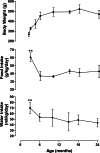Differential effects of aging on fluid intake in response to hypovolemia, hypertonicity, and hormonal stimuli in Munich Wistar rats
- PMID: 16492769
- PMCID: PMC1413909
- DOI: 10.1073/pnas.0511099103
Differential effects of aging on fluid intake in response to hypovolemia, hypertonicity, and hormonal stimuli in Munich Wistar rats
Abstract
A significant proportion of aged humans may have impaired thirst and inadequate fluid intake after a period of fluid deprivation. We have studied the water drinking responses, relative to body weight, of Munich Wistar (MW) rats in response to osmotic, hypovolemic, dehydrational, and angiotensin (Ang)-related stimuli as they aged from 3 to 24 months. Young 3-months-old (m.o.) rats had the largest daily fluid intakes and drinking responses to hypertonic and dehydrational stimuli, suggesting that they have accentuated thirst in comparison with older age groups. There were no differences in daily fluid intake from 6-24 m.o.; however, drinking responses to i.p. injection of hypertonic 0.4 mol/liter NaCl gradually declined over this period so that in 24-m.o. rats the response was only half that of 6-m.o. rats. Water intake after 24-h water deprivation also declined gradually over 24 months. Drinking responses to hypovolemia induced by s.c. injection of colloid (polyethylene glycol) were unchanged in 6- to 15-m.o. rats, then declined precipitously in 18- to 24-m.o. rats. Drinking responses to s.c. Ang II or s.c. isoproterenol were not reduced in 24-m.o. rats, nor was the drinking associated with feeding. Therefore, there are specific impairments of water intake in response to hypertonicity and hypovolemia in aged MW rats, but Ang-related drinking is not reduced. Like aged humans, aged MW rats exhibit high plasma atrial natriuretic peptide levels and impaired cardiovascular reflexes that could contribute to the impairment of thirst with age.
Conflict of interest statement
Conflict of interest statement: No conflicts declared.
Figures





Similar articles
-
Reductions in water and sodium intake by aged male and female rats.Nutr Res. 2012 Nov;32(11):865-72. doi: 10.1016/j.nutres.2012.09.014. Epub 2012 Oct 25. Nutr Res. 2012. PMID: 23176797
-
Plasma angiotensin II levels and water intake following beta-adrenergic stimulation, hypovolemia, cellular dehydration and water deprivation.Pharmacol Biochem Behav. 1976 Mar;4(3):317-21. doi: 10.1016/0091-3057(76)90248-3. Pharmacol Biochem Behav. 1976. PMID: 6974
-
Osmoregulatory fluid intake but not hypovolemic thirst is intact in mice lacking angiotensin.Am J Physiol Regul Integr Comp Physiol. 2008 May;294(5):R1533-43. doi: 10.1152/ajpregu.00848.2007. Epub 2008 Feb 20. Am J Physiol Regul Integr Comp Physiol. 2008. PMID: 18287219
-
Control of thirst and salt appetite in rats: early inhibition of water and NaCl ingestion.Appetite. 2006 Mar;46(2):234-7. doi: 10.1016/j.appet.2006.01.003. Epub 2006 Feb 24. Appetite. 2006. PMID: 16499997 Review.
-
Disturbances of thirst and fluid balance associated with aging.Physiol Behav. 2017 Sep 1;178:28-34. doi: 10.1016/j.physbeh.2017.03.003. Epub 2017 Mar 4. Physiol Behav. 2017. PMID: 28267585 Review.
Cited by
-
Drinking and arterial blood pressure responses to ANG II in young and old rats.Am J Physiol Regul Integr Comp Physiol. 2010 Nov;299(5):R1135-41. doi: 10.1152/ajpregu.00360.2010. Epub 2010 Aug 25. Am J Physiol Regul Integr Comp Physiol. 2010. PMID: 20739604 Free PMC article.
-
Impaired Fluid Intake, but Not Sodium Appetite, in Aged Rats Is Mediated by the Cyclooxygenase-Prostaglandin E2 Pathway.Front Aging Neurosci. 2020 Feb 28;12:19. doi: 10.3389/fnagi.2020.00019. eCollection 2020. Front Aging Neurosci. 2020. PMID: 32184716 Free PMC article.
-
Age-related declines in thirst and salt appetite responses in male Fischer 344×Brown Norway rats.Physiol Behav. 2014 Aug;135:180-8. doi: 10.1016/j.physbeh.2014.06.010. Epub 2014 Jun 19. Physiol Behav. 2014. PMID: 24952266 Free PMC article.
-
Effects of β-adrenergic receptor agonists on drinking and arterial blood pressure in young and old rats.Am J Physiol Regul Integr Comp Physiol. 2011 Apr;300(4):R1001-8. doi: 10.1152/ajpregu.00737.2010. Epub 2011 Feb 9. Am J Physiol Regul Integr Comp Physiol. 2011. PMID: 21307363 Free PMC article.
-
Hypotension- and osmotically induced thirst in old Brown Norway rats.Am J Physiol Regul Integr Comp Physiol. 2009 Jul;297(1):R149-57. doi: 10.1152/ajpregu.00118.2009. Epub 2009 May 6. Am J Physiol Regul Integr Comp Physiol. 2009. PMID: 19420291 Free PMC article.
References
-
- Phillips P. A., Rolls B. J., Ledingham J. G., Forsling M. L., Morton J. J., Crowe M. J., Wollner L. N. Eng. J. Med. 1984;311:753–759. - PubMed
-
- Mack G. W., Weseman C. A., Langhans G. W., Scherzer H., Gillen C. M., Nadel E. R. J. Appl. Physiol. 1994;76:1615–1623. - PubMed
-
- Phillips P. A., Johnston C. I., Gray L. In: Thirst: Physiological and Psychological Aspects. Ramsay D. J., Booth D., editors. London: Springer; 1991. pp. 403–411.
-
- Ainslie P. N., Campbell T., Frayn K. N., Humphreys S. M., MacLaren D. P. M., Reilly T., Westerterp K. R. J. Appl. Physiol. 2002;93:714–723. - PubMed
Publication types
MeSH terms
Substances
LinkOut - more resources
Full Text Sources
Medical
Miscellaneous

